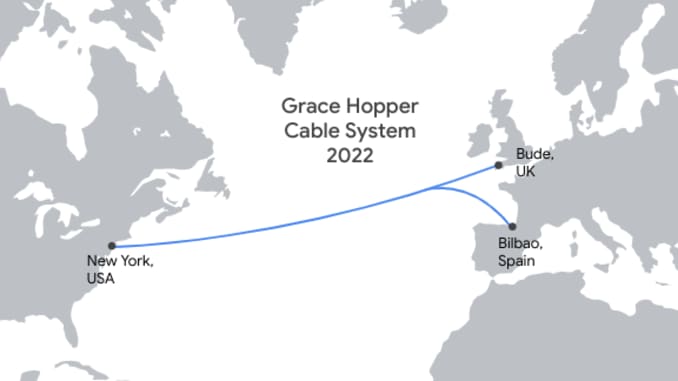Google is Building a Massive Undersea Cable Connecting UK, US and Spain
Google announced Tuesday it intends to set up a new Grace Hopper undersea fiber-optic cable between the U.S., the U.K., and Spain as part of an effort to improve its services.
The cable — named Grace Hopper after the American computer programming pioneer — will provide “better resilience for the network that underpins Google’s consumer and enterprise products,” Google said.
“Once commissioned, the Grace Hopper cable will be one of the first new cables to connect the U.S. and U.K. since 2003, increasing capacity on this busy global crossroads and powering Google services like Meet, Gmail and Google Cloud,” said Bikash Koley, vice president of Google Global Network, in a blog post.
“It also marks our first investment in a private subsea cable route to the U.K., and our first-ever route to Spain,” Koley said. “The Spanish landing point will more tightly integrate the upcoming Google Cloud region in Madrid into our global infrastructure.”
The Mountain View-headquartered company added that the cable will incorporate “novel optical fiber switching” that will allow it to move traffic around internet outages more competently than before. It will also have 16 fiber pairs (32 fibers), which is a “significant upgrade” to the internet infrastructure that connects the U.S. with Europe, Koley said.
The cable will run along the ocean floor from New York to the Cornish seaside resort town of Bude in the U.K. and Bilbao in Spain. It will run 6,250 km from the U.S. to the U.K. and 6,300 km from the U.S. to Spain.
Google signed a contract earlier this year with underwater cable provider SubCom, which is headquartered in New Jersey, and the project is expected to be finished in 2022. Google declined to say how much the new cable is costing the company.

Subsea cables ferry 98% of international internet traffic around the world. These cables make it possible to share, search, send and receive information around the world at the speed of light.
Shelter-in-place measures globally amid the coronavirus pandemic have placed increased strain on existing networks with demand for data-intensive services like Netflix and Zoom surging.
“The COVID-19 pandemic has put a spotlight on connectivity, highlighting how ingrained it is in our daily lives,” said Tom Meyer, a general manager and group vice president at technology analyst firm IDC Europe. “These challenging times have taught us that a stable and reliable network is no longer a ‘nice to have’ but business critical.”
“Naturally, investment into infrastructure is a major priority, particularly as connectivity becomes an ever-increasing necessity going forward,” Meyer said.
Google said it was “thrilled” to honor Hopper, who was a U.S. Rear Admiral and inventor of the first human language-computer code compiler.
Facebook cable
In May, Facebook announced it was building an undersea cable around Africa to boost internet access in the continent.
The social media company has partnered with the likes of China Mobile, South Africa’s MTN, France’s Orange and Britain’s Vodafone as well as local network operators on the project, dubbed 2Africa.
It’s tasked Nokia-owned cable systems provider Alcatel Submarine Networks with building the subsea cable. At 37,000 kilometers — or about 22,991 miles — in length, Facebook claims the cable will be “nearly equal to the circumference of the Earth.” It’s not yet clear how much funding Facebook and its partners have put behind the project.


